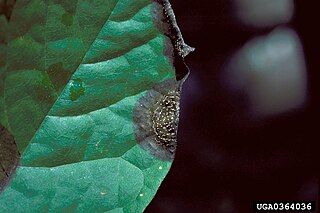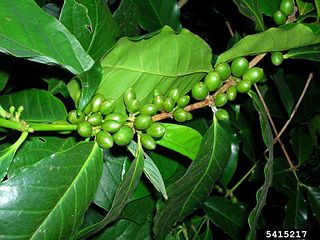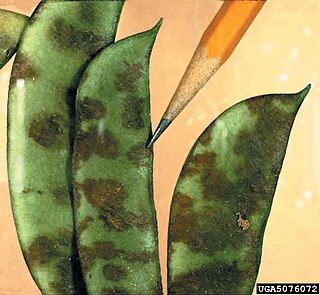Glomerella graminicola is an economically important crop parasite affecting both wheat and maize where it cause the plant disease Anthracnose Leaf Blight . Certain cereal varieties that have been genetically engineered. may be more susceptible to the teleomorph phase of the fungus.

Colletotrichum acutatum is a plant pathogen. It is the organism that causes the most destructive fungal disease, anthracnose, of lupin species worldwide. It also causes the disease postbloom fruit drop on many varieties of citrus, especially Valencia and navel oranges in Florida.
Colletotrichum trifolii is a fungal plant pathogen of alfalfa, causing the disease alfafa anthracnose. It is a biotroph, obtaining nutrients from the living plant cells before forming asexual spores. This fungus has two known races Bain and Essary.

Colletotrichum kahawae is a fungal plant pathogen that causes coffee berry disease (CBD) on Coffea arabica crops. The pathogen is an ascomycete that reproduces asexually. The asexual spores (conidia) are stored within acervuli. This disease is considered to be one of the major factors hampering C.arabica production in the African continent, which represents the current geographic range of the fungus. Coffee berry disease causes dark necrosis in spots and causes the green berries of the coffee to drop prematurely. High humidity, relatively warm temperatures, and high altitude are ideal for disease formation. Given the severity of the disease and the lack of effective control measures, there is great concern that the fungus may spread to other coffee producing continents, such as South America, which could have catastrophic consequences.
Colletotrichum capsici is a species of fungus and plant pathogen which causes leaf blight on Chlorophytum borivilianum, basil, chickpea and pepper as well as dieback in pigeonpea and anthracnose in poinsettia.

Colletotrichum coccodes is a plant pathogen, which causes anthracnose on tomato and black dot disease of potato. Fungi survive on crop debris and disease emergence is favored by warm temperatures and wet weather.

Colletotrichum lindemuthianum is a fungus which causes anthracnose, or black spot disease, of the common bean plant. It is considered a hemibiotrophic pathogen because it spends part of its infection cycle as a biotroph, living off of the host but not harming it, and the other part as a necrotroph, killing and obtaining nutrients from the host tissues.

Colletotrichum orbiculare is a plant pathogen of melons and cucumber. It causes the disease anthracnose that can effect curcubits causing lesions on various parts of the plant. It can effect cucumbers, melon, squash, watermelon and pumpkin, especially when the weather is rainy, humid and warm. It can be transmitted by seed as well as soil and survive between crops. It is also spread by feeding cucumber beetles, splashing water, tools and workers. Efforts to control the fungus include the practice of rotating cucurbits out for a 2-year period, planting cultivars with resistance, burning infected crops and careful control of weeds. Chemical control measures are also available.

Glomerella cingulata is a fungal plant pathogen, being the name of the sexual stage (teleomorph) while the more commonly referred to asexual stage (anamorph) is called Colletotrichum gloeosporioides. For most of this article the pathogen will be referred to as C. gloeosporioides. This pathogen is a significant problem worldwide, causing anthracnose and fruit rotting diseases on hundreds of economically important hosts. Laid out here is an overview of some of the most important aspects of this pathogen.

Colletotrichum sublineola is a plant pathogen that causes anthracnose in wild rice and sorghum
Colletotrichum musae is a plant pathogen primarily affecting the genus Musa, which includes bananas and plantains. It is best known as a cause of anthracnose indicating ripeness on bananas.

Colletotrichum is a genus of fungi that are symbionts to plants as endophytes or phytopathogens. Many of the species in this genus are plant pathogens, but some species may have a mutualistic relationship with hosts.
Colletotrichum cereale is a plant disease (fungus) that has been found to cause crown rot anthracnose of turf grass most commonly occurring on golf courses. Anthracnose can occur as both a foliar blight and basal rot. This disease attacks the crowns of plants, which is different than other anthracnose diseases. Anthracnose of turfgrass can be a foliar disease or in this case a basal rot of the lower portion of the plant. It attacks different species of turfgrass throughout the world most commonly annual bluegrass and creeping bentgrass.
Pecan anthracnose is a fungal disease of pecan trees caused by the ascomycete Glomerella cingulata (Stoneman) Spauld. & H. It is a widespread disease found wherever pecan trees are grown. Pecan anthracnose has been reported as far back in time as 1914, and as far away as Argentina. Glomerella cingulata has two anamorphs which cause disease on pecan trees, Colletotrichum gloeosporioides and Colletotrichum acutatum. The occurrence of Colletotrichum on pecans has contributed to a significant decline in pecan production in various years. An increase in the incidence of pecan anthracnose is highly correlated with heavy rainfall, especially heavy rainfall occurring in early spring. The severity of symptoms increases as the season progresses, often culminating in leaf drop in the late autumn. This defoliation is linked to lower yield and poorer quality of nuts.
Colletotrichum hanaui is a falcate-spored graminicolous plant pathogenic fungi species, first isolated from warm-season grasses.
Colletotrichum nicholsonii is a falcate-spored graminicolous plant pathogenic fungi species, first isolated from warm-season grasses.
Colletotrichum paspali is a falcate-spored graminicolous plant pathogenic fungi species, first isolated from warm-season grasses.
Colletotrichum miscanthi is a falcate-spored graminicolous plant pathogenic fungi species, first isolated from warm-season grasses.
Colletotrichum axonopodi is a falcate-spored graminicolous plant pathogenic fungi species, first isolated from warm-season grasses.
Hemibiotrophs are the spectrum of plant pathogens, including bacteria, oomycete and a group of plant pathogenic fungi that keep its host alive while establishing itself within the host tissue, taking up the nutrients with brief biotrophic-like phase. It then, in later stages of infection switches to a necrotrophic life-style, where it rampantly kills the host cells, deriving its nutrients from the dead tissues.






